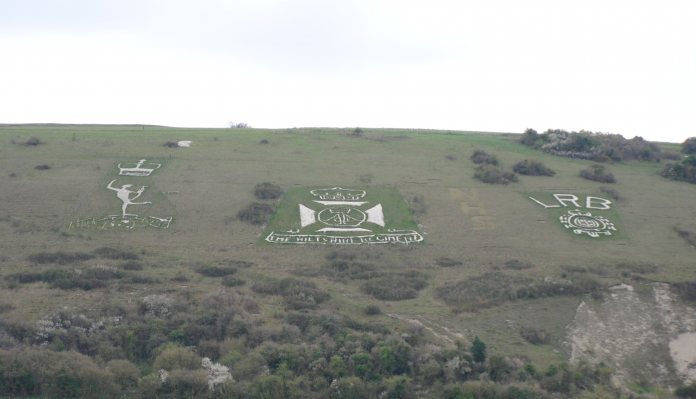The Badges of Fovant
-
0
 Comments
Comments
- Last updated: 09/07/2023

During the First World War, soldiers had the urge to leave some form of expression behind them when they were moved to another location, just like many men for hundreds of years before them. They just wanted to create a reminder to say that they had been there. It could be in the form of hand-written graffiti on a barrack wall, or something more permanent, like carving initials into wooden panels or stonework. Examples of this can be found at certain points along what was the Western Front, such as Vimy Ridge, where Canadian soldiers fought.
Closer to home, these reminders can be found at locations in Britain, such as Richmond Castle in North Yorkshire. However, nothing can be compared to the evidence left behind on the hills around Fovant, just north of the A30 trunk road between Sutton Mandeville and Compton Chamberlayne in Wiltshire. The surrounding area was once filled with military camps, where up to 20,000 troops from different regiments were accommodated in wooden huts. Facilities included cinemas, canteens, and medical and dental clinics to serve infantry, artillery, and other branches of the army. A military railway was built to serve this infrastructure.
It is believed that men from the London Rifle Brigade were the first to leave their mark behind. They did this by carving a huge regimental cap badge onto a hillside in 1916. The hills in the area are formed from chalk, and by scraping away the topsoil, the image could be defined in the exposed white chalk. The base of the hills served as the target impact area, known as the ‘butts’, on the rifle ranges where firing commenced at 7am. This limited the times when work could be undertaken, but the end result could be seen from a great distance.
Other regiments were inspired to follow suit, and by 1918, there were some 20 regimental cap badges and national symbols carved into the chalk hills. For example, at Hurdcott there was a huge map of Australia, while at Sutton, the 7th Battalion, The City of London Regiment, and the Royal Warwickshires carved their cap badges. Some of these images covered an area measuring over 160 x 80ft. To emphasise the design, chalk was carried to the site of some badges to make them more visible and to help them last over time.
Today, all traces of the camps have disappeared. The railway has been dismantled, and evidence of their existence is scant. Over time, 11 of the original badges have also disappeared, mainly through weathering, leaving only 9 to be seen. Fortunately, those that remain are maintained and preserved to serve as a reminder of the soldiers who served there, just as they were intended.
The badges are cared for by volunteers of the ‘Fovant Badge Society’ (www.fovantvillage.com/badges-society), which includes the YMCA, the Devonshire Regiment, the Royal Warwickshire Regiment, and the Australian Commonwealth Military Forces. The latter is the largest, measuring 167 x 104ft.
It is sad that some of the history has been lost, and if it were not for the Fovant Badge Society, which raises money for the upkeep of the memorials, more would certainly have disappeared.
The badges on the hillside, which is located two miles west of Fovant village at Sutton Mandeville, are listed as scheduled ancient monuments, and recognised as war memorials. Each year, on the first Sunday in July, a special Drum Head Service is held at East Farm to commemorate the men who served in WWI. Details, including timings, can be found on the website.
It is possible to get close to the badges by driving along an unclassified road, which has very basic, limited parking by a muddy track. Visitors have to get out and walk along paths which are really intended for allowing maintenance work to be carried out. However, the best viewing point to see them from is the A30 road, where lay-bys are provided to allow visitors travelling in either direction to park safely.
There are other similar chalk carvings in the area dating from the same period, all of which are of interest to military enthusiasts. These are not connected to the Fovant Badge site, which remains the most famous, but each is important, such as the tribute to the New Zealand troops at Bulford, which takes the form of a giant kiwi. This lies about 20 miles from Fovant, and, while not as famous, it is well worth seeing in conjunction with the others as a reminder of what these symbols represent.
